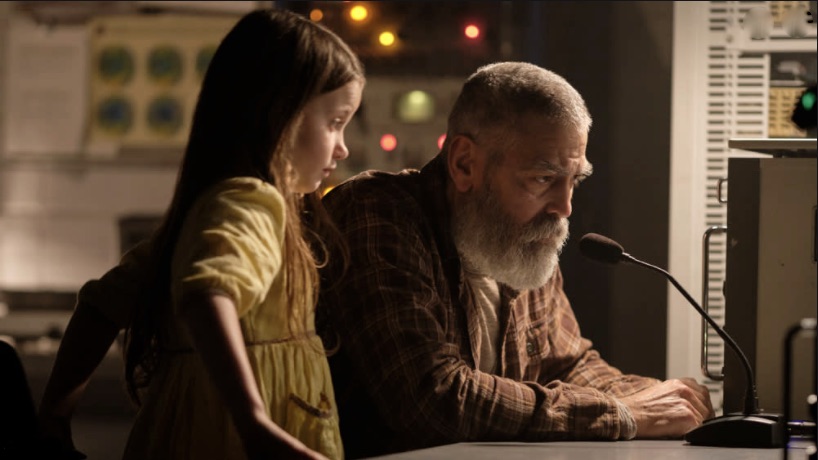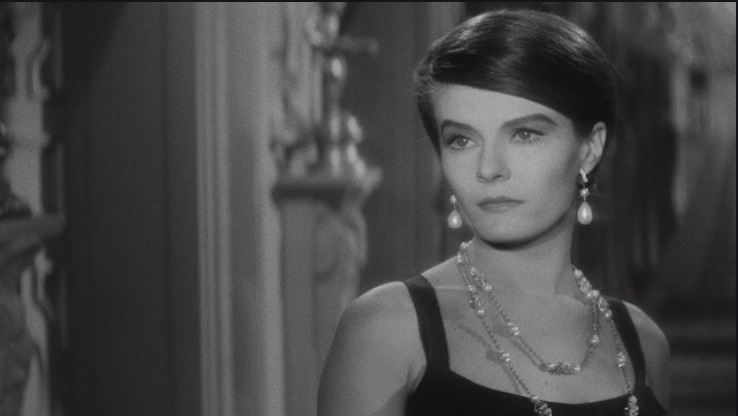
“He’ll never die – he costs too much.” I said this to myself but I was imagining that I was saying it to my daughters. Neither of them was present at the time. I was referring to the possible fate of George Clooney who, only halfway through ‘The Midnight Sky’ on Netflix, was attempting to retrieve a suitcase of vital technology from a cabin module that was rapidly sinking beneath a wasteland of melting Antarctic ice. It was a well designed jeopardy, almost too well designed. If he got the case he would drown in icy water for sure, thereby abandoning the eight year old girl who was accompanying him on their fraught pilgrimage from one frozen place to another. But, of course, he didn’t perish and he saved the tech. I mean, he was also the director and you don’t kill off your lead, especially when it’s you.
I imagined I was George Clooney directing the scene where he loses the little girl in the snow storm that cut visibility to a couple of meters and wolves were circling and George has this rifle apparently made of bone like the guy had in Cronenberg’s ‘Existenz’ (1999). I remember the gun more than the rest of that film possibly because the rendering of the various VR worlds was quite lame, as if Cronenberg, for once in a career full of cysts, gristle and bursting body parts, had climbed on the wagon a little late. The gun was bone so you could smuggle it through metal detectors. It shot teeth.

First of all I would equip the young actress with a tracking device concealed beneath her anorak then I would provide three runners with tracker receivers and radios and despatch them in a crescent around the girl but just outside the visibility range. Before each shot, one of the assistants, stationed by the camera, would do a radio check in the course of which each runner would confirm that they have a tracker signal from the actress.
That’s not quite right. It would be me, as the director, not an assistant, calling the radio check. The reason is I feel fatherly towards girls of that age because my daughters were once that age. I felt and feel fatherly at all their ages, I should add.
After each shot I would tell the runners to converge on the actress to see she was bearing up okay. There would be a chaperone there anyway but they would stay behind the camera.
The thing is, however, that at no point in the scene I’m referring to are the girl and Clooney visible at the same time. Clooney runs about in the snow storm shouting at wolves then realises he can no longer see the girl. So the girl could spend that time in her trailer, keeping warm, along with the chaperone. At no point does she walk out of shot into the swirling white-out.
But that’s how I would do it, anyway. In the film the little girl only speaks about six words but when I, in my role as George Clooney, go on Graham Norton with her to promote the film, Caolinn Springall, who is 7, would prove to be charmingly and unstoppably chatty, much to the benign amusement of the host and assembled guests. From time to time I would be seen smiling fondly, paternally and with a hint of proud surprise. I’m not sure how you pronounce her first name but obviously I would have found out in the course of the casting.

The thing is, however, that at the end of the film she disappears anyway. Not in the snow or anything but because she is a figment of George Clooney’s imagination that he had conjured in order to get him through the chill task of taking tech from one frozenarse installation to another. Which, again, is lame. Seen it all before. So when he nearly loses her in the snow storm and almost falls into deathly sleep in the snow it’s control over the figment that he is losing rather than someone’s real daughter.

If you want to do this figment stuff and not be lazy then you could pick up some tips from George Clooney, who plays Chris Kelvin in Steven Soderbergh’s ‘Solaris’ (2003) and encounters, to his initial delight and astonishment, on board an orbiting space station, his dead wife Rheya, played by Natascha McElhone whom I saw walking along in Brick Lane once but did not approach in order to assert that “I love what you do”. The stark uncanniness of the situation doesn’t stop Kelvin from becoming increasingly enchanted by the figment, which is generated by incomprehensible forces radiating from the water-covered planet around which Kelvin’s space craft is orbiting.
If Soderbergh’s work was overly legible, a view held by some, then a more substantially credentialed, elusive and earlier version of Stanislaw Lem’s original novel was made by Tarkovsky in 1972. At almost twice the length it drifts in and out of the ponderous but it got there 20 years earlier and has fuelled my thinking on the figment ever since.
Lem, I was amused to discover, thought both versions sucked. He “never really liked Tarkovsky’s version” and despite never actually seeing Soderbergh’s film wrote “…to my best knowledge, the book was not dedicated to erotic problems of people in outer space… As Solaris’ author I shall allow myself to repeat that I only wanted to create a vision of a human encounter with something that certainly exists, in a mighty manner perhaps, but cannot be reduced to human concepts, ideas or images. This is why the book was entitled “Solaris” and not “Love in Outer Space”. (Wikipedia re both versions.)
Kelvin gets over his astonishment and finds that if you fire your figment into deep space in a capsule in order to annihilate her she will reappear a few hours later as if nothing had happened. Which, in a sense, is very much the case. The haunted Kelvin then decides that getting back the wife who had, in the real world, committed suicide ten years ago, could be quite agreeable, especially if you can overlook the fact that you know perfectly well she is a figment, somehow condensed from the probings of an intelligent planet into your unconscious while you sleep.

Rheya, however, develops a tentative autonomy which takes the form of a frustrated introversion:
I do remember doing things but I don’t remember being there. I don’t remember experiencing those things…These strange thoughts keep coming into my mind and I don’t know where they’re coming from.
Strip out the genre trappings and ‘Solaris’ becomes a treatise on invasive, unwanted, unwelcome thoughts, experienced by many and, I would venture to say, all people. The especially perturbed hosts to these invaders may on occasion report to doctors and therapists who might, it is hoped, help to dispel or at least cauterise the vile inbursting outbursts.
In the absence of sage counselling some of the sufferers from unwanted thoughts will feel colonised. The thoughts are so unlike them that they must be disowned, at which point a question of relocation arises. The thoughts are not a sign of madness. The thoughts are demonic. The thoughts are messages from those we have angered or betrayed. They are beamed by extra-terrestrials, they come from God.
Such thoughts, experienced as alien and inescapable marauders, may be thought of as symptomatic of the inhabiting of a culture in which a proliferation of fragments exerts an attritional pressure on unitary identity. As the shell grows ever thinner so it becomes crazed, in the ceramicist’s sense of being covered in fine cracks.
Traffic flows both ways: from the outside to the inside and vice versa. Rheya, located in Kelvin, not beside him, is experienced by him as a person in the world. She, however, becomes the receptacle for Kelvin’s recollections of her past. They aren’t her memories, they couldn’t be. They’re what Kelvin unconsciously injects into his phantasmal mannequin.
Although she’s not real, Rheya presents as the porous and benighted emissary of a burgeoning crazedness. Ideally, from Kelvin’s point of view, she wouldn’t be so fussy – she would embrace his memories of her as if they were her own and the couple could resume their relationship, presumably at a point before she committed suicide.
It occurs to me that all Kelvin has to do is remember her remembering that all her memories are her own. Problem solved. But perhaps Kelvin isn’t psychopathic enough to go the whole hog.
In Kelvin’s case, there is an urgency born of protracted and perhaps uncompleted mourning. There is nothing he would like better than for his wife to rise from the dead. He knows it’s mad. But he will overlook this. His wife, however, in her capacity as a figment, acquires qualities that no figment should or could. She starts to think for herself.
Rheya’s acquisition of what we are initially asked to regard as independent thought prompts a consideration of the Tibetan tulpa – the ultimate expression of expression or, if you prefer, the ultimate extension of the logic of expression.
The early scriptures of Tibetan Buddhism advise that a holy person could envisage another living thing, perhaps human or humanoid or homunculus, and then, over a long period, intensify that act of imagining to the point where they might become familiar with every detailed physical aspect of that being and then push and push and finally endow that vivid vision with actual materiality, so that you could touch it, talk with it, have it as a companion, recognise that it is a true tulpa, or in current parlance a ‘thoughtform’. In the parlance of sceptics, an ‘imaginary friend’.
If such activities strain credulity then their cultural power, and the power of their western ilk, endures and will be found to inform many everyday adventures in books, films and fictions; all sorts of actors and characters in those works; many varieties of vision, delusion and hallucination; any number of hauntings, enchantments and abductions; myriad yearnings, longings and cravings and pinings and mournings. Countless conjurations and invocations can be regarded as having as their engine an embedded, ancient, insistent and unstanchable conviction – a wish, really – that proper cogitation can be actualised – it is a process of manufacture, one that might feature birth or resurrection or replication.
In your dreams.
So Rheya sits on the end of the bed and tells Kelvin about her troubling mental life. Only a while ago she had no mental life: her thoughts were channelled into her spectral yet material being by an unthoughtful Kelvin who didn’t know he was doing it. She was a bewitching prosthetic serving to actuate a bereaved husband’s attempt to forestall closure. She also has, of course, a prophylactic function, that of deferring Kelvin’s knowledge of the fact that the dead don’t come back. If Kelvin gets too close to her she may slip back inside him and undo the whole charade. If he doesn’t get close enough to her he runs the risk of becoming overly objective and effectively killing her off.

That a pallid, enervated person could be in any way attractive is puzzling. Is death warmed up your idea of fun? Most would say no. On the other hand the withholding of emotion and emotional expression has long been found irresistible in many quarters. In ‘Ex Machina’ (Garland, 2014) Caleb, (Domhnall Gleeson), finds himself drawn to Ava (Alicia Vikander), a female robot equipped with sophisticated AI. Ava’s designer is using Caleb in an elaborate Turing test that dispenses with the non-visibility of the artificial intelligence and instead confronts Caleb with complete evidence of its artificiality.

Ava: Would you like to know how old I am?
Caleb: Sure.
Ava: I’m one.
Caleb: One what? One year or one day?
Ava: One.
As is the way in guy-fucks-robot movies, fascination is steadily supplanted by ruminations on acquisition and enslavement. These latter are not made explicit. Deckard (Harrison Ford), for example, in ‘Blade Runner’ (Scott, 1982), never says of the replicant Rachael (Sean Young) “I’ve always wanted to fuck a robot.” Caleb never says to Nathan (Oscar Isaac), the millionaire scientist who made Ava the woman she isn’t, “She’s so like the real thing, I really want to fuck her.” (Nathan is already fucking Kyoko, an early model with less advanced sentience than Ava.) At the level of plot the male leads are increasingly drawn to the humanoids but somehow we are led to empathise with the men on the basis that, well, these gadgets are lovely to look at and will always listen uncritically to what I have to say. And you can keep them in a clean, dry cupboard.

Deckard: Remember when you were six? You and your brother snuck into an empty building through a basement window. You were going to play doctor. He showed you his, but when it got to be your turn you chickened and ran; you remember that? You ever tell anybody that? Your mother, Tyrell, anybody? Remember the spider that lived outside your window? Orange body, green legs. Watched her build a web all summer, then one day there’s a big egg in it. The egg hatched…
Rachael: The egg hatched…
Deckard: Yeah…
Rachael: …and a hundred baby spiders came out… and they ate her.
Deckard: Implants. Those aren’t your memories, they’re somebody else’s. They’re Tyrell’s niece’s.
Deckard: [he sees that she’s deeply hurt by the implication] O.K., bad joke… I made a bad joke. You’re not a replicant. Go home, O.K.? No, really – I’m sorry, go home.
Valerie Solanas, in the SCUM Manifesto (1968), observed that a man will ‘swim a river of snot, wade nostril-deep through a mile of vomit, if he thinks there’ll be a friendly pussy awaiting him.’ This may partially explain the malleability of romantic lead Caleb. Several areas of Ava’s body are attractive, it must be said, but you can see through her lower trunk to the room on the other side. In that trunk-space are cables, actuators and artificial muscles. You couldn’t say that you didn’t know what you were getting. The ‘friendly pussy’ is not in evidence but Ava has a pretty face and, in terms of contours if not contents, a beach body. She cannot, however, be compared to the replicant Rachael in Blade Runner who is entirely organic with no artificial parts other than her suite of other people’s memories. But Ava does not share Rachael’s melancholy and, although Caleb doesn’t quite get this, Ava understands that he needs to be understood. Harrison Ford’s Deckard is content to overlook the fact that everything Rachael remembers derives from the niece of her designer and drives off with her in a flying car at the end of the movie. Caleb falls in love, notwithstanding the anatomical cut-away aspects of Ava’s limbs and midriff.

The inscrutable woman possessed of an elusive, even absent, interiority is, when constituted in a particular way in either arthouse or horror films, always a figment. In ‘Last Year at Marienbad’ (Resnais, 1961) most of the cast lack the conventional signs of interiority and it’s nothing to do with bad acting. They gaze into the middle distance, move very few facial muscles and are immaculately groomed. Their passions and objectives are unreadable. If we were to declare that they are impenetrable then we would be saying, at the risk of stating the obvious, that they cannot be penetrated. And this, in turn, makes them both challenging and attractive. If it could also be said that they seem half-dead then we might wish to revitalise them. There are limits to this: if it is clear that the person is, for example, very ill, in the medical sense, then there will be no charm attached to the situation. That sort of illness is simply not good enough. It’s too specific. Tuberculosis maybe, but nothing that involves rot. Zombies are undeniably riveting but the brides of Dracula are also enticing.
The film elegantly considers a three-line premise: a man, ‘X’, (Giorgio Albertazzi) approaches a woman, ‘A’, (Delphine Seyrig) at a magnificent hotel and tells her that they met a year ago in Marienbad, where they had an affair and agreed to meet a year later. A denies ever meeting or knowing X. He tries to convince her but is consistently rejected.

A – What room? I’ve never been in any room with you.
X – But you don’t want to remember. You’re afraid.
One view of this protracted enigma sees X as a gaslighting pest. It is even possible, but unlikely, that it is his persistence that drives A to the distraction that makes her remote and undemonstrative. It is hard not to see her putting up with him by politely minimising her transactional presence.
The guests at the hotel are all similarly dazed, however, which weakens the gaslighter proposition. A’s protestations may genuinely indicate either an impaired memory or a condition in which the hotel is a place of pervasive entrancement akin to that in the Hotel California where “You can check-out any time you like, But you can never leave!”
If these circumstances are the case then the film becomes a study of a kind of psychic refuge in which memory can be allowed to deteriorate in order to facilitate the management of multitudes that are malign as distinct from enriching. A side effect of this strategy might be the intermittent emergence of invasive thoughts.
Rheya, A, Ava and Rachael have differing degrees of embodiment and autonomy but you can imagine their being imagined rather than actually enfleshed. They are tulpas and if you get it right they will let you do any sex thing you want. You can even use them as arm-candy that will not assert, at the end of the day, that they are tired. What’s not to crave? Certainly in the films cited the men, especially Caleb, are variously thwarted or have to work hard but those are just trappings. At the conclusion of a feature-length tease you can boil off the plot and character stuff and go full Tibetan. Implicit in this formula is that the duration of a feature film, say 100 minutes, is all you need to make your dreams come true. Granted, this is to mix up levels but it’s quicker than meditating in a cave.
Mira, the cyborg female in ‘Ghost in the Shell’ (2017) has a shell that is realistically fleshlike, encasing robotic limbs and inner organs but driven by her own human brain. She has, in fact, full human lineage but as a result of extensive physical damage sustained in a cyberterrorist attack she is used as a platform for an innovative cyborg attack model that employs a human brain rather than artificial intelligence. In common with her more passive aforementioned sisters her condition is an outcome of the dreams of men.

Conveniently for all who would wish to take advantage of her, Mira, like Rheya and A and Rachael, has an imperfect memory. She tells her cyborg colleague that
It feels like there’s always this thick fog over my memory…I don’t remember much. Just fragments. Bits and pieces.
In order that troubling thoughts about predatory necrophilic masculinism do not contaminate an engagement with the generally science fictional nature of cyborg narratives, a slow tease strategy is often deployed wherein the foregrounding of a fascination with robotics and replicants enables the connoisseurial savouring of futurescapes while suppressing darker ruminations.
This have your cake but critique it strategy is seen to good effect in the 1975 and 2004 versions of ‘The Stepford Wives’. Both versions indict the capture, commodification and sexual enslavement of compliant wives by their spouses yet both feature protracted episodes during which the accessibility of an ever ready fuckpiece is seen to be even more gratifying than a fast car.
The older version, directed by Bryan Forbes, at 115 minutes, plays the tease at length and holds off the stabbing of newly robotised and erstwhile dissident Bobbie (Paula Prentiss) by her disillusioned non-robotised friend Joanna (Katharine Ross) until the 98th minute, while the lighter, less sedate 93 minute Frank Oz (2004) version places the first significant robot Wife malfunction at just under 25 minutes.
These incidents precipitate random, repetitive, deranged and unwifely behaviour as the ladies’ circuits buzz, spark and burn out. The covert celebration of the advantages of wifely docility is muffled by plotting which clearly signals that all will not be well and, it should be said, is brought to an abrupt conclusion with a satisying and comedic critique of the imperial males.
The erotics, the enslavement and mastery, the themes of futurephobic anxiety and incomplete recall characterise many cyborg/replicant movies but it is the amnesia that has a special currency. In the course of the current (April 2021) covid-19 national lockdown, memory malfunction, attention deficit, ‘brain fog’ and confusion have been widely reported in the UK and beyond by those who have had to endure their own or unusually limited company for the last several months. The lack of incident (for those without covid), the flattened psychic topography, the smoothing of time have all exposed a simultaneously restless and listless populace to the usual atomised attention-seeking cultural radiation that is pretty much the weather in the mediated world but is currently adulterated by the natural inclination of our own attention to register as much activity as possible. This otherwise vital aptitude, when deprived of any hierarchies of importance to attend to, will hop and hop and hop from one thing to the next then the next then the next.
The term ‘attention deficit’ is slightly confusing insofar as it is the ability to pay sustained attention that is compromised, not the amount of attention that is available. In our waking hours attention is ever present. It needs somewhere to go, however, and will go there willy-nilly.
It seems likely that in such conditions the identification of events that merit recollection is undermined by the proliferation of countless incidents of apparently equal importance. Amnesia prevails as well as an attendant anxiety precipitated by our falling prey to thoughts and responses that are usually held in check by matters that genuinely do require our full attention.



22.01.2021

